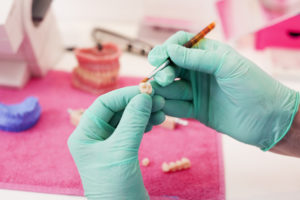 Ponte Vedra Complete Dentistry is dedicated to providing the most current dentistry possible. Recent years have shown us technological advances that have revolutionized dentistry. Digital impressions, CAD/CAM technology, dental implant advances, and crowns in one day are some of the breakthroughs that we have seen recently.
Ponte Vedra Complete Dentistry is dedicated to providing the most current dentistry possible. Recent years have shown us technological advances that have revolutionized dentistry. Digital impressions, CAD/CAM technology, dental implant advances, and crowns in one day are some of the breakthroughs that we have seen recently.
What is a Dental Crown?
Our natural teeth, if broken down to two major segments, are made of a root and a crown. The root is the part of the tooth under the gum and is what anchors the tooth into the bone. The crown is the visible portion of the tooth in the mouth. When we have decay that is significant, severely fractured or broken teeth, or teeth that have been endodontically treated, the dentist often needs to place a crown. A crown is a shell that is placed over the remaining segment of the tooth to provide support, function, and esthetics. It can be made of porcelain, gold, a combination of both, etc. For purposes of simplicity, we will refer to the natural crown of the tooth as a crown and the restoration as a dental crown.
What is the Traditional Procedure for a Dental Crown?
Traditionally, the dental crown procedure is composed of two or more visits. First, the dentist reduces much of the tooth structure all around the crown of the tooth. This provides room for the new dental crown. Decay will be removed. If the decay is very large and is removed, often the remaining tooth structure is not large enough to support the new dental crown. From there, a buildup is performed. This is either composed of a dental composite or amalgam. The dentist will then take an impression of the prepared tooth and send it to the lab with instructions regarding shape, size, and color. The lab then sends the fabricated dental crown to the dentist and the patient comes back a second time to have the crown placed in the mouth.
What is the “Crowns in a Day” Variation?
New technology has allowed us to fabricate a crown and place it in one dental appointment. This is done through CAD (computer-aided design) CAM (computer aided manufacturing). The dentist will take a digital impression of the prepared tooth with a special scanning wand. This image is sent to a 3D software program. The dentist can then enter into the system and design a dental crown to the exact desired specifications. From there, the dentist can send that information to a milling machine that is in the office. The machine creates the dental crown. The crown is then placed in the patient’s mouth during the same appointment as the preparation.



